|
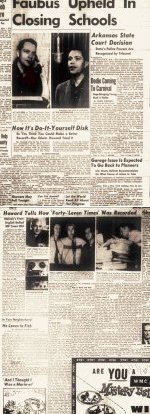
|
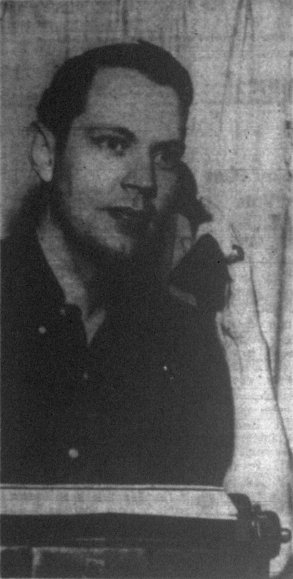
|
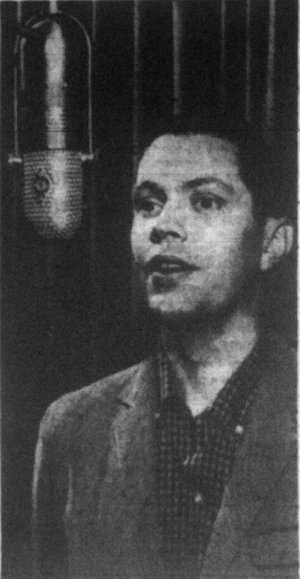
|
|
Press-Scimitar Staff Photos by
George Pierce
|
| AT HIS DESK at The Press-Scimitar,
Howard's daily chores include plenty of typing and telephoning. He
covers movies, plays and books for the paper, and writes the weekly
theatrical column, The Front Row. |
AT THE MICROPHONE in the Sun Record
Co. studio. Howard sings for his do-it-yourself disk, "Forty-'Leven
Times," and "More Pretty Girls Than One," released today on the
Phillips-International label.
|
Now It's Do-It-Yourself Disk
So you Think You Could Make a Better Record?--Our Edwin Howard Tried It
The following story by The Press-Scimitar's amusements editor, Edwin Howard, was released to more than 800 newspapers thruout the
country today by Newspaper Enterprise Association, one of the
nation's largest feature services. In The Press-Scimitar, two more articles by Howard on the recording industry will appear
tomorrow and
Wednesday. These will tell what he learned about the
comparatively new Memphis industry-from the inside-while himself making a record for national release.
By EDWIN HOWARD
MEMPHIS. -- Almost everybody has 'turned on a radio or dropped a dime
in a juke box, listened a moment, and said: "Why; I could make a
better record than that!"
More-have said it than have acted on it, of course. But the do-it-yourself
craze has carried 0ver into the record business, all right.
Thousands of- people, from truck drivers to movie stars are making
records-and thousands more want to.
But what are the average shower-shouter's chances of turning out a
hit?
To try to find out, I set out to make a record myself.
Because the recording industry in no longer centered in New York and
Los Angeles, I didn't even have to leave home. I found I could make a
record on a leading internationally distributed label, right here in Memphis. Only time time-and the record·buying public —can tell
whether my record will become a hit or not, but it is made and is being
released today to record shops all over the country.
'Forty-’Leven Times'
My do-it-yourself disk is "Forty-'Leven Times"- a song I
wrote myself-backed with "More Pretty Girls Than One," on the
Phillips International label.
Doing it myself didn't turn out to be quite what I expected; tho.
Just one person doesn't make a record---whether better or worse than the
prevailing platters. It may not take the the voice of a Como, but I
found it does take time, teamwork, and patience.
Heard of the team that made 'Forty-'Leven Times" is Sam
Phillips, head of Sun Record Co., and discoverer of Elvis Presley, Jerry
Lee Lewis, Bill ("Raunchy") Justis, and Johnny Cash.
Phillips is one of the country's five or six top independent record-makers
and there are as many as 4000 of them, including the one-timers who try to
a hit, and run.
I proposed to Phillips that he make and release a record of
Turn to Page 12 - HOWARD
Page 12
Howard Tells How 'Forty-'Leven Times' Was
Recorded

"THEY COME IN from all over the sticks, man' says Bill
Justis. "We end up recording maybe one out of a hundred."
THE TAPE RECORDER, control panel of which is
shown here, is the device which made possible the rise of the
independent recording companies in Memphis and other cities
outside New York, Chicago and Los Angeles which formerly dominated
the recording field.
|
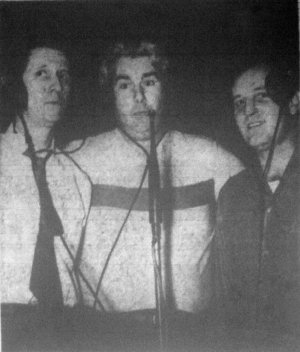
VOCAL GROUP heard echoing Edwin Howard on
"Forty-'Leven Times is made up of, left to right: Bill Abbott,
tenor, Vernon Drane, bass, and Lee Holt, baritone. Guitar background
on the record was provided by Jack Clement, Sid ("Raunchy")
Manker, and Bill Riley.
|

PILE OF MAIL, tape recordings of singers and
songs hopefully submitted from all over the country, hid the control
board as Jack Clement engineered Howard's recording session at Sun.
Clement has now started his own company, Summer Records.
-Press-Scimitar Staff
Photos
|
|
|
Melody's From English Ballad 300 Years Old
(continued from Page 1)
me
singing my own new "country" lyrics, with a beat, to a
mournful old hillbilly waltz called "'There's More Pretty Girls
Than One," He agreed to go along with the idea. He didn't bother
listening to me sing. Apparently gimmicks are as important in the record
business as voices, and I had a gimmick, at least. "If you sound
too bad," he said, "we can always cover you up with a vocal
group."
Phillips turned me over to his director of artists and repertoire (A.
& R.) Bill Justis, bop talking bandleader whose Phillips
International recording of "Raunchy," which he wrote with
Guitarist Sid Manker, sold well over a million copies, Just last week
Justis went into business himself, his new label being Play Me Records.
A big part of an A. & R. Man's job, especially with an
independent company like Sun, is auditioning talent, which these days
mean mostly singers.
One Out of 100
"They come in from all over the sticks, man," Justis told
me while he was with Phillips. "We end up recording maybe one out
of a hundred." He auditioned songs, too. "Everybody wants to
do the songwriting scene. We get like 50 or 60 a day thru the mail on
tapes. Most of them are real nothing. We use maybe one out of every 400
we listen to. It can be a real drag, but most of our hits have been
originals by the artists who recorded them, or by somebody in Memphis.
We have four or five who write for us exclusively, and of course they
get more material recorded than anybody."
One of Sun and Phillips International's regular composers was Jack
Clement, a Jack of all musical trades who handled the control board for
my recording sessions. Besides composing and engineering, Clement did A.
& R. work and was himself a recording artist. He, too , has just
started his own company, with the name, Summer Records.
Altho new studios are being built, Sun still operates out of the tiny
studio to which Elvis Presley went just over five years ago to make a
record at his own expense for his late mother.
Office space is at such a premium that business is often transacted
and lead sheets written in Taylor's Restaurant (plate lunch: 60 cents)
next door. In fact Taylor's has been to Rock and Roll what Pee Wee's
Saloon on Beale Street (where W. C. Handy wrote "Memphis
Blues") was to the blues.
'A Good Sign'
It was in a booth at Taylor's that Justis first heard my new lyrics
and rhythm for "More Pretty Girls Than One." He was
unimpressed. "But that's probably a good sign. man," he
reassured me. "If I hate something it usually turns out to be a
hit."
Justis asked if I had anything in mind for the other side of the
record. I said I had an idea for a song to one of the several tunes to
17th century English ballad, "Barbara Allen." (Such songs are
in the public domain - that is, they are uncopyrighted. By writing new
lyrics to a "P. D." tune, an author can claim full
author-composer royalties on it."
What I finally wrote on a piece of copy paper, using the studio piano
as a desk was "Forty-'Leven Times," a romantic ballad with, I
think, a folksong sound. At first Justis liked this even less than
"More Pretty Girls," and I was encouraged. But over the months
(18 from idea to record release), it grew on him. He made an
arrangement (all in his head; he writes music, but not many guitar
players read it), using three guitars and a vocal trio. Now he thinks it
has a good chance of becoming a hit.
I spent 15 hours working with Justis in preparation for the recording
session which resulted in the released record.
Phillips himself listened to the various "cuts" and offered
suggestions as to how they could be improved. The term "cut"
is a hold over from the time when records actually were cut with a sharp
, wedge-shaped needle. Now only the "master," from which the
pressings are made, is cut. All the preliminary recording is done on
magnetic tape. The tape recorder has revolutionized the recording
industry in the past 10 years and is responsible for the rise of the independent
companies.
Rise of Rock and Roll
Fifteen years ago, there weren't more than 10 recording companies in
the whole country-not as many as are operating in Memphis today. Only
the big companies in New York and Los Angeles could afford the delicate
and expensive equipment and the large, acoustically perfect studio
which were then required for making records.
Today, all you need to go into the record business is an Ampex-type
tape recorder and a room with a good "sound" to record in. Of
course, once you're in business, it takes know-how to make hits. A touch
of genius and a little luck help, too. It is the tape recorder-more than
any other single thing-that is responsible for the rise of Rock and
Roll. Tape took the recording business out of the hands of a few big
bands and vocalists in New York and Los Angeles and put it into the
hands of dynamic young people to whom music was not a profession but an
emotion. Like it or not, Rock and Roll is what resulted when they
started putting that emotion on record.
Many a record hit has been made at the control board rather than the
microphone, however. "Witch Doctor," "Purple People
Eater," and "The Chipmunk Song" are three of the more
obvious electronic hits. But who know where Ricky Nelson, Pat Boone --
and yours truly -- would be without electronic echo chambers? Most
voices sound better - as you probably know from singing in the shower -
with an echo effect which lends resonance and covers up the quavers.
Phillips Liked It
Once Justis got the echoey sound he wanted for "Forty-'Leven
Times" and "More Pretty Girls Than One" on tape, Phillips
had to give his final O. K. and test a release date. Phillips listened
to the final "Forty-'Leven Times" tape over and over again,
waxing more enthusiastic each time. By the time the master was cut and
sent to the pressing plants, he was much more interested in the record
itself than in the story I got making it.
Whether or not "Forty-'Leven Times" clicks, I found out
these four things which would-be recording artists would do well to
ponder:
1. Thanks to the tape recorder, which brought the recording industry
out of its three or four ivory towers and into hundreds of grass-roots
recording shacks all over the country, there are more opportunities than
ever before for quick fame and fortune on the spinning disks.
2. However, only about one in every 100 persons who audition is ever
actually recorded, and not more than one in several hundred records
released can become a real hit.
3. And this one-out-of-hundreds hit is hardly ever what you could
call a do-it-yourself project. It takes teamwork to make a hit
record-from the head of the company right down thru the A. & R. Man,
the composer, the artist, and the promotions staff. It also takes a
"sound" that appeals to the record-buying public. Sometimes
the song itself provides that sound. Sometimes it is something in the way
it is recorded. Sometimes it is a certain quality in the voice of the
singer. Many successful recording artists cannot perform well before
live audiences. And many top performers just don't go over on records.
4. But for the lucky few, who aren't so few as they used to be, the
rewards range from considerable to staggering. The average minimum
artist's royalty on a single record is about 3 cents a copy; the average
maximum is about 5 cents a copy. Composers draw from three fourths to a
full cent a side. Thus the artist on a million-selling record stands to
make between $30,000 and $50,000. And if he has also written his own material,
he can add another $20,000 (or more, if others record his tune) to his
bank account.
No wonder everybody wants to make a record.
Article by Edwin Howard - April 27, 1959
Memphis Press-Scimitar courtesy Memphis Public Library
article added September 11, 2013
This article is reprinted exactly as it appeared in the
April 27th 1959 edition of the Memphis Commercial Appeal for posterity.
See also the 2nd and 3rd
of this series and the studio page on Sam Phillips
Recording Service.
"Cowboy" Jack Clement
Jack Henderson Clement had a long association with Sun and its artists. He was born in Whitehaven near Memphis in 1931.
His musical career began in Washington, DC while in the serving in the
Marines, a four year hitch that ended in 1952. By 1954 he had returned
to Memphis where one of his first gigs was as emcee and singer in Sleepy-Eyed "John" Lepley's eight piece swing band at the
Eagles Nest when Elvis, Scotty and Bill began appearing. As a co-founder of Fernwood Records in 1956 he recorded Billy Lee Riley and brought the tapes to
Sam Phillips which resulted in a job with Sam and a contract for Riley at Sun. Scotty
himself would later join Fernwood in 1958 and produce a hit for Thomas Wayne, the brother of Luther Perkins.
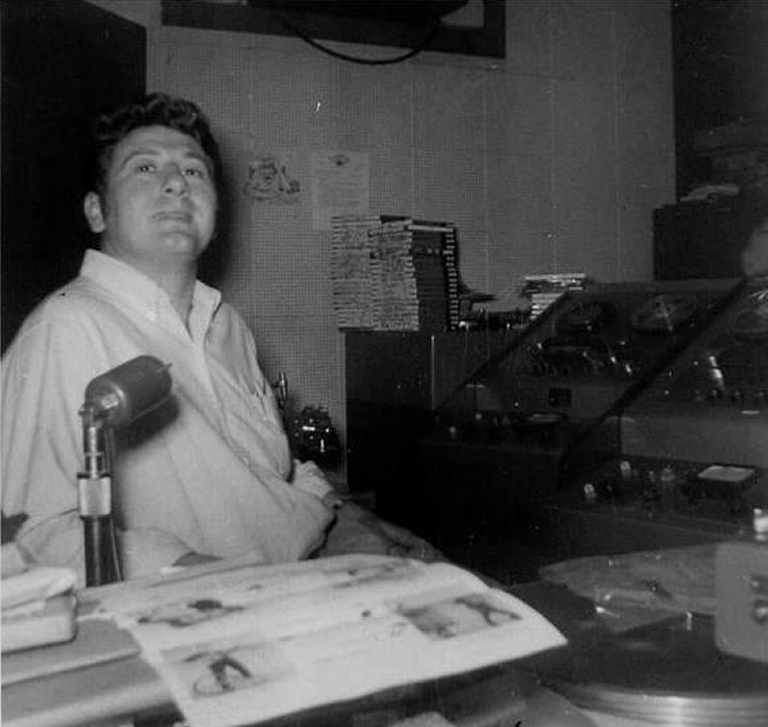
Jack Clement at Sun in Memphis - ca. 1958
Photo courtesy
Martin Willis
According to Colin Escott, Clement was the first person to whom Sam
Phillips entrusted the technical side of his operations, although
Phillips soon discovered that he had hired someone with views radically
different from his own.
At Sun, Clement would record Roy Orbison, Jerry Lee Lewis’ biggest hits, and write several songs for Johnny Cash
(“Ballad of a Teenage Queen”; “Guess Things Happen That
Way"). Unlike Sam, in
the studio, Clement would work with the musicians changing keys, chord
progressions and arrangements.
In December of 1956 during a session with Carl Perkins that Elvis happened to drop in on he had the foresight to turn on the recorders as an informal jam that also included Jerry Lee and Johnny Cash ensued, which quickly became known as the
Million Dollar Quartet. It would take many years, however, for the tapes to surface, no doubt due in no small part to a prohibitive clause in Elvis'
contract with RCA.
After being fired by Sam in 1959 Clement moved to Nashville briefly to work for Chet Atkins
before relocating to Beaumont, TX where he met George Jones and convinced him to cut the song,
"She Thinks I Still Care." In 1965, Clement returned to Nashville and financed a demo by then-unknown Charley Pride and persuaded Atkins to sign him to RCA. Clement also wrote Pride's first two hits,
"Just Between You and Me" and "I Know One," and produced Pride's first 13 albums for the label.
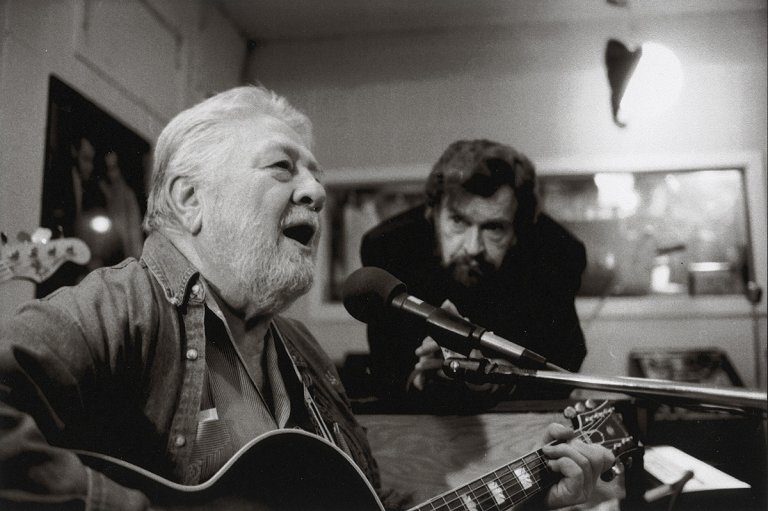
Jack Clement (1931 - 2013) and Sam Phillips at Sun Studios in
Memphis - ca. 2000
Photo courtesy Noisey
Clement also continued to work closely with Johnny Cash after their time
at Sun. He was responsible for arranging the mariachi horn part on the 1963 hit
“Ring of Fire”, writing several of the songs on the Cash's live album
At Folsom Prison, and played with Cash on his final “American
Recordings” LPs. In the '80s Clement produced three tracks for U2's
Rattle and Hum sessions in Memphis, at Sun. In recent years he produced sessions
for Eddy Arnold, did soundtrack work with T Bone Burnett for the film
Walk the Line, and hosted weekly shows Sirius satellite radio.
Jack Clement was nominated to the Country Music Hall of Fame this year, but died on August 8th in Nashville from liver
cancer. He will be inducted posthumously this October. Of his bonds with Sam Phillips, Sam's son Knox said,
“To my father, Jack was very much like Elvis or Johnny Cash, any of the people he worked with or discovered. Sam saw him as a creative genius, this tower of strength. You know, the two of them could sit and have high level conversations speaking totally in
metaphor,” said Phillips, laughing. “Sam loved him dearly. He had many different artists, but there was only one
Jack.”
added September 11, 2013
Much of what's presented here about Jack Clement is courtesy Cowboy
Jack Clement, Colin Escott's
Good Rockin' Tonight and Jack's obituary by Bob
Mehr in the Commercial Appeal.
|









